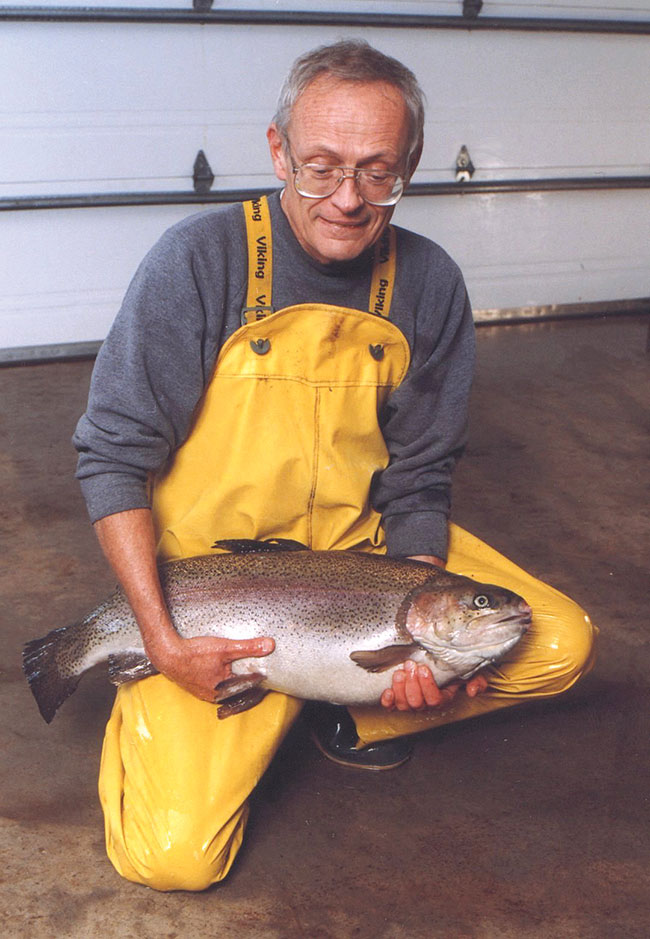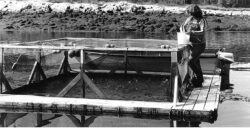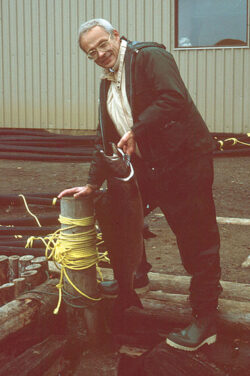
A tribute to aquaculture pioneer, A.M. (Arnie) Sutterlin
December 4, 2023
By Cyr Couturier (With contributions by T. Benfey, G. Fletcher, B. Glebe, D. Stevens, D. Runighan, A. MacKay)
 With Arnie, it was always about the fish, shown here proudly holding a large female rainbow trout ready to spawn.
Photo: D. Runighan
With Arnie, it was always about the fish, shown here proudly holding a large female rainbow trout ready to spawn.
Photo: D. Runighan Dr. A.M. Sutterlin passed away peacefully in July 2023 at his home in Souris, P.E.I., just shy of his 85th birthday. He is survived by his wife, Melitta (of Bay d’Espoir NL), and daughter, Nancy (Sutterlin) Clements, and grandchildren, Cape Breton, N.S.
Arnie, as he preferred to be called, was a true pioneer in the Canadian aquaculture scene. He will be remembered for his curiosity, wit, intellect, and by most, for that impish look in his eyes with pending humorous outcomes to follow.
His curiosity is what drove him, in my view. It occasionally got him into trouble, as he once confided that he spent some time in reform school during his formative years for being “too inquisitive”, but that did not deter him from pursuing a PhD and postdoctoral fellowship in fish physiology in the 1960s and feeding his curiosity further. The true essence of Arnie was to drive that curiosity with passion towards finding solutions to grow fish and support the people who grow them. He had come to love the coast and nearby oceans during his early days in Maine, USA.
He began his fish career in the early 1970s at the St. Andrews Biological Station (SABS), then part of the Fisheries Research Board of Canada, working as a fish physiologist with scientist Dr. Dick Saunders, and then Director Dr. John Anderson. Arnie’s main job was to find ways to allow the restocking program operated by the International Atlantic Salmon Foundation (IASF; now the Atlantic Salmon Federation) to improve returns to Bay of Fundy rivers. Afterall, the newly constructed dams in Mactaquac and nearby rivers were causing some distress in wild fish populations, and hatcheries were built for enhancement purposes.
Throughout the ’70s Arnie and colleagues experimented with various salmonid hybrids, better ways to promote smoltification, and basic protocols for growing salmonids. The Norwegians had been working with Saunders at SABS on smolt physiology in the 1960s and began to develop salmon farming in the 1970s. So, naturally Arnie spent some time teaching and researching aquaculture in Norway from 1976-1978 on an exchange program, where he learned a little more about this new activity, salmon net pen farming.

First net pen of salmon for growth trials off Deer Island, N.B., in 1978. Photo: A. MacKay
Arnie returned to the SABS in the late 1970s and transferred some of the excess smolts from the government stocking program to Deer Island where a young local biologist, Art MacKay, had secured a grow-out location for the fish and had been advocating for farming for several years. Working with his technician Gene Henderson and Art, they were able to produce Canada’s first ocean-raised Atlantic salmon by the late 1970s, and so it began.
Arnie was offered a position as scientist at Memorial University’s Marine Science Research Laboratory (MSRL) in the late 1970s to help develop finfish and shellfish aquaculture there. A place where he could apply his craft and curiosity to developing finfish aquaculture in Newfoundland (he hired me in 1981 to take over the duties for shellfish development).
Before leaving Memorial in 1984, to be with family and work for DFO Ottawa, Arnie had demonstrated with his graduate students and the Miawpukek First Nations that Atlantic salmon could be grown and overwintered on the south coast of the island of Newfoundland, a place with unique oceanographic conditions.
During this same time at the MSRL, Arnie began developing sterilization techniques for trout and salmon with his MSc student T. Benfey leading those efforts, developed the first RAS system using ozone in Canada for raising salmonids, developed artificial baits for cod longlining, conducted experiments on improving fry diets with a post-doc (L. Clarke), and so on.
At about the same time in the early 1980s, Arnie was still concerned about growing salmon in the cold waters of Newfoundland, and thereby encouraged MSRL colleagues Garth Fletcher and Choy Hew to undertake the world’s first gene transfer of winter flounder antifreeze protein gene into the Atlantic salmon genome.

Arnie with male broodstock at the original Bay d’Espoir hatchery in Camp Boggy, St. Alban’s, N.L.
Photo: T. Benfey
The lure of development brought Arnie back to Newfoundland in 1986 to begin construction of the first salmon hatchery at Camp Boggy next to the Bay d’Espoir hydro plant, near St. Alban’s, N.L., the thought being the warmer spill water could increase growth of the fish to smolt size. John Holder was hired by Arnie to construct the hatchery and become its first manager. Meanwhile Arnie continued to assist local entrepreneurs in developing net-pen technology as well as hatchery-nursery technology through the 1980s. Following this, he did a stint in Indonesia and Southeast Asia before being recruited to A/F Protein Inc. in the early 1990s by Dr. Fletcher, the patent holder on AquAdvantage transgenic Atlantic salmon, containing a Pacific salmon growth hormone gene in its genome.
Arnie moved to PEI to assist in the research and development of A/F Protein’s broodstock, development of all-female triploids, and further developing RAS technology for land-based salmon farming. A/F Protein Inc. eventually traded as AquaBounty Farms in the early 2000s and later to AquaBounty Technologies to begin the long arduous process of seeking approval to farm GM salmon for food with the U.S. Food and Drug Administration (FDA) and with Health Canada and Canadian Food Inspection Agency. All the while, Arnie was involved in mentoring graduate students (Cogswell and Cook) at the facility, as well as staff, working on husbandry improvements for the fish and developing improved methods for farming overall.
Arnie was a true pioneer in finfish aquaculture in Canada, and he spent some time on the Board of Directors of the Aquaculture Association of Canada in the 1990s, was a founding member of the Aquaculture Association of Newfoundland (AANF 1987) and was recognized in the early 2000s as the Atlantic Canada Aquaculturist of the Year. Arnie once told me he had little patience for “no-can-do attitudes and bureaucracy”, and just to get on with it. His efforts certainly show how he excelled with this attitude; one many aspire to emulate. His exceptional development skills and willingness to go beyond the confines of the ordinary, as well as his curiosity, made for an inventive and productive career in Canadian aquaculture. Arnie will be missed by all those who knew him, and I am sure we will miss that twinkle in his eyes when coming up with a new idea or solution or concept to feed his curiosity.
Advertisement
- Sustainable Blue loses 100,000 salmon due to system failure
- USDA to conduct 2023 census of aquaculture





